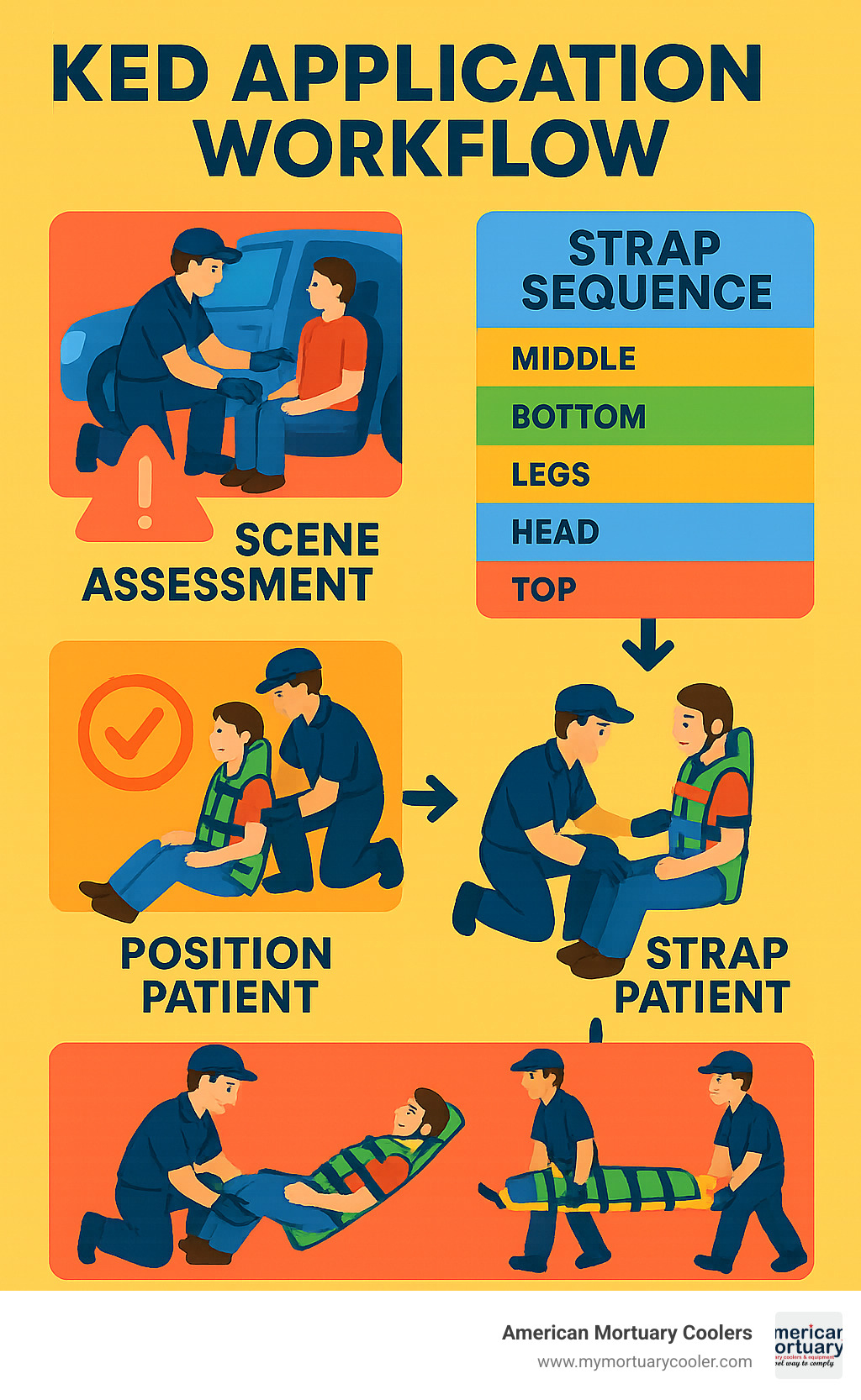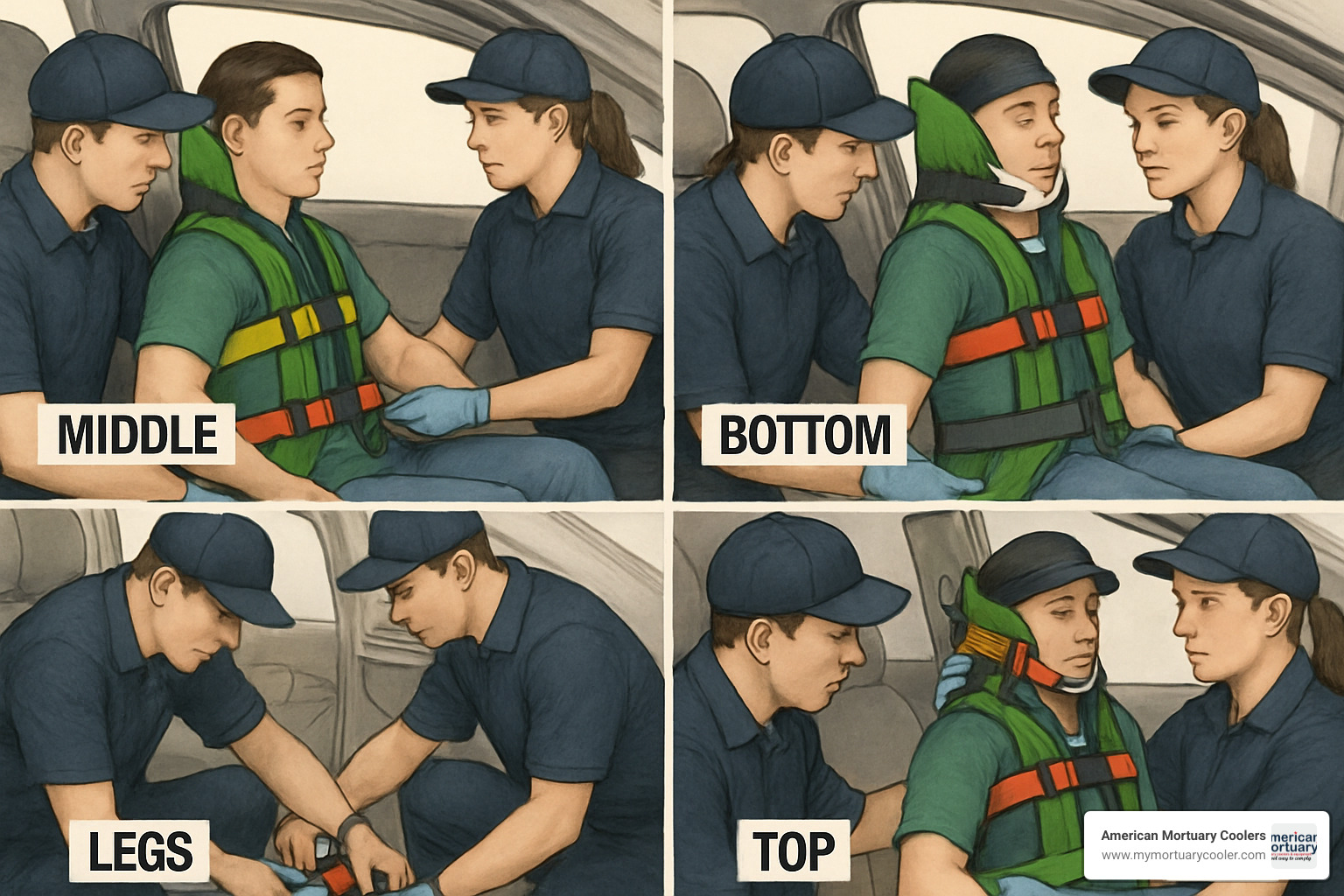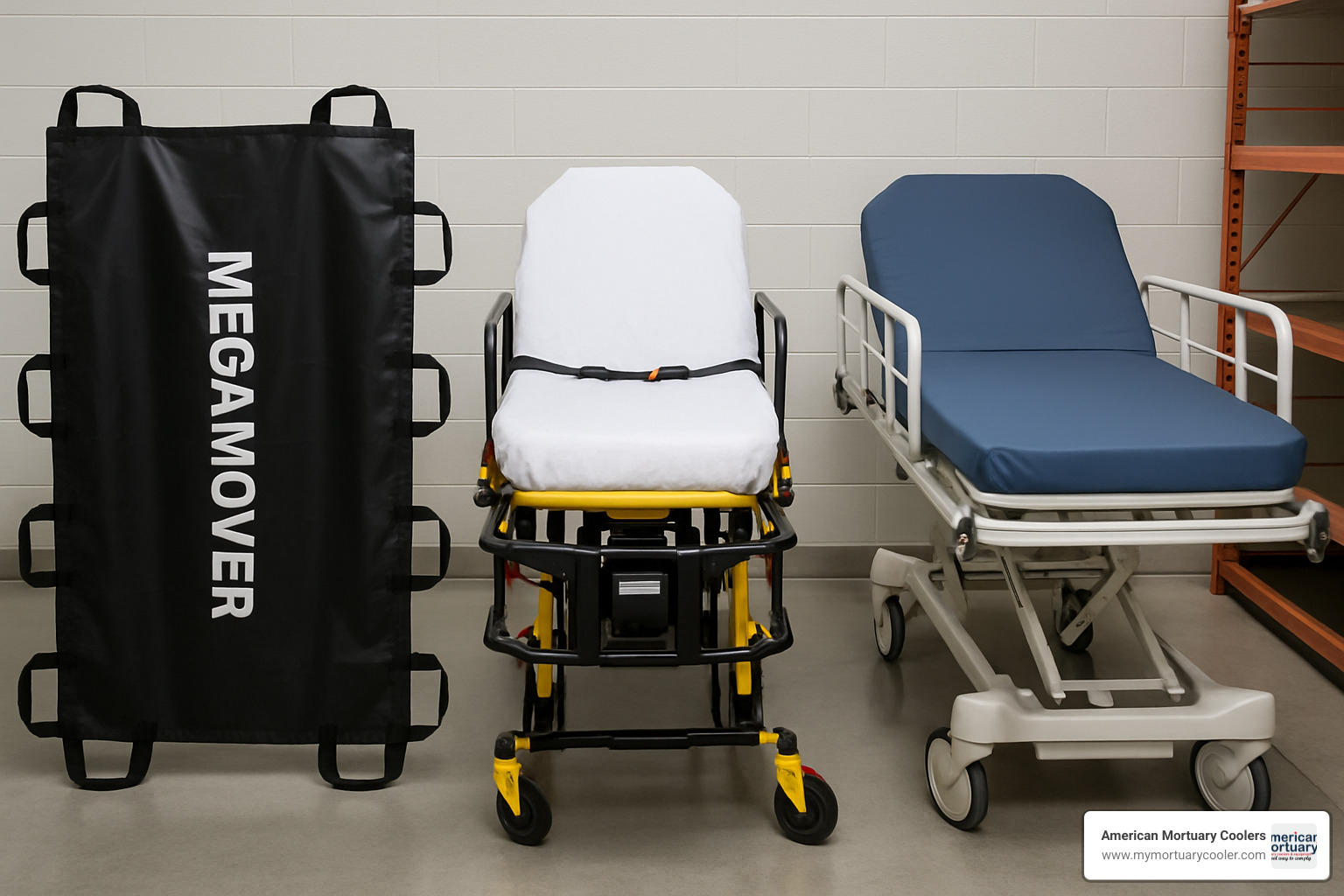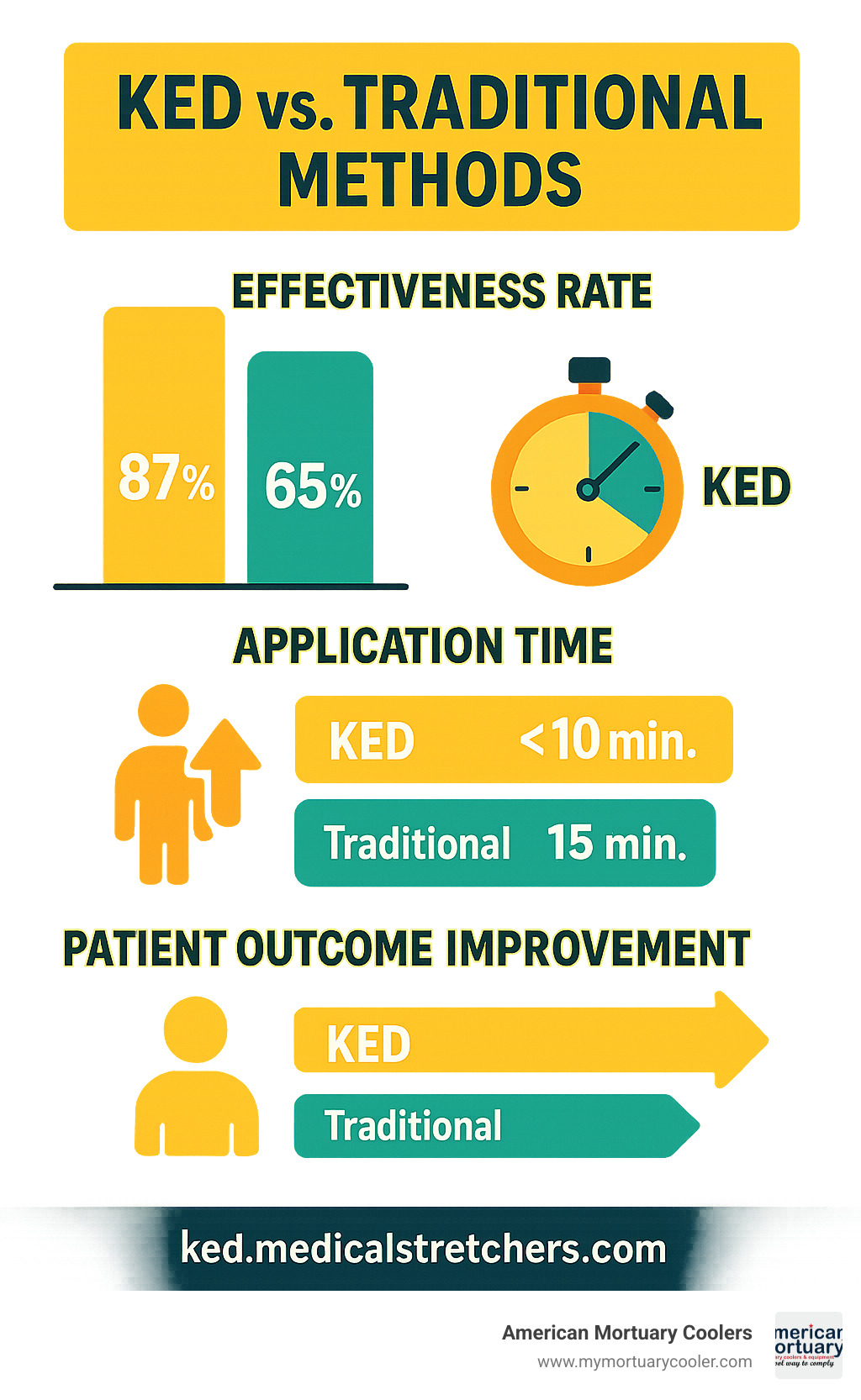Why the Kendrick Extrication Device is Essential for Emergency Response
ked' www.medicalstretchers.com offers the MOBI-KED Adult & Pediatric Extrication Device, a specialized spinal immobilization tool designed for safe patient extraction from vehicles and confined spaces. This lightweight 8-pound device supports up to 500 pounds and features color-coded straps for rapid deployment during emergency situations.
Quick Facts About ked' www.medicalstretchers.com:
- Weight: 8 lb (3 kg) for easy transport
- Dimensions: 33" x 32" compact storage
- Capacity: 500 lb (227 kg) load rating
- Design: Universal fit for adults, pregnant patients, and pediatric cases
- Features: Color-coded straps, carrying case, vertical rigidity with horizontal flexibility
- Price: $67.95 for complete device with case
The Kendrick Extrication Device (KED) revolutionized emergency medical services when Dr. Richard Kendrick developed it in the late 1970s. This semi-rigid vest immobilizes the head, neck, and torso while allowing responders to safely extract seated patients from dangerous situations.
Unlike traditional spine boards, the KED works specifically with seated patients trapped in vehicles or confined spaces. The device slides behind the patient and uses a systematic strap sequence - remembered by the mnemonic "My Baby Looks Hot Tonight" (Middle, Bottom, Legs, Head, Top) - to secure proper spinal alignment during extraction.
As American Mortuary Coolers, we've worked with funeral homes and emergency services for years, helping them select reliable equipment including ked' www.medicalstretchers.com devices for their transport needs. The MOBI-KED stands out for its durability and American distribution support that busy professionals require.

Terms related to ked' www.medicalstretchers.com:
Understanding the Kendrick Extrication Device
Picture this: it's the late 1970s, and emergency responders face a frustrating dilemma. A patient sits trapped in a mangled car, conscious but potentially injured. Traditional spine boards won't fit. Time is ticking. Dr. Richard Kendrick saw this problem and decided to solve it once and for all.
His breakthrough came from understanding what responders really needed - a device that could stabilize spinal alignment while actually working in the real world. The KED wasn't just another piece of equipment; it was a complete rethinking of how emergency extraction should work.
The design principles behind every KED focus on one critical balance: maintaining spinal alignment while giving responders the flexibility they need. Think of it as creating a protective shell around the patient's spine that can bend with the situation but never compromise safety.
What makes the ked' www.medicalstretchers.com MOBI-KED special is its color-coded straps system. Instead of guessing which strap goes where during a high-stress emergency, responders follow a simple pattern. The colors guide them through the "My Baby Looks Hot Tonight" sequence - Middle chest, Bottom chest, Legs, Head, and Top chest straps.
The 500-pound load capacity means this device handles nearly every patient you'll encounter. Whether it's a petite teenager or a larger adult, the pediatric-adult compatibility eliminates guesswork about which device to grab from your ambulance.
Here's something that really matters in the field: radiolucent materials. When you arrive at the hospital, doctors can take X-rays without removing the KED first. This keeps the patient stable while giving medical teams the information they need to make treatment decisions.
Scientific research on KED effectiveness backs up what responders have known for decades - proper spinal immobilization during extraction makes a real difference in patient outcomes.
Anatomy of a KED
Every KED starts with its main body - the semi-rigid backbone that slides behind your patient. This isn't just a piece of plastic; it's engineered to provide exactly the right amount of support while staying flexible enough for tight spaces.
The chest flaps wrap around like a protective vest, distributing pressure evenly across the patient's torso. These adjustable panels adapt to different body sizes without creating pressure points that could cause additional injury.
Pelvic binders prevent the patient from sliding down during extraction. Think about lifting someone vertically from a car seat - without proper pelvic support, gravity becomes your enemy.
The head immobilizer system keeps the cervical spine in proper alignment. Forehead and chin straps work together to prevent dangerous head movement while still allowing the patient to communicate with responders.
Carry handles integrated into the device transform the patient and KED into a single, manageable unit. These aren't afterthoughts - they're positioned specifically to help responders maintain proper lifting mechanics while keeping the patient stable.
Typical Use-Case Scenarios
Vehicle collisions remain the bread and butter of KED use. When someone's conscious and sitting upright after an accident, the KED lets you stabilize them properly before attempting extraction.
Confined spaces present unique challenges that the KED handles beautifully. Industrial accidents, construction incidents, or even recreational mishaps in tight spots benefit from the device's compact profile and systematic application process.
Industrial incidents involving heavy machinery often leave patients seated but unable to move safely. The KED's design accommodates these challenging scenarios where traditional extraction methods simply won't work.
Seated-fall rescues happen more often than you might think. Elderly patients who fall in bathrooms, individuals stuck in recreational equipment, or anyone who ends up trapped while seated - these situations call for the KED's specialized approach.
Bariatric patients present their own set of challenges that the ked' www.medicalstretchers.com device addresses head-on. With its 500-pound capacity and adjustable design, it accommodates larger patients who might not fit properly in standard spine boards or other immobilization devices.
Why Choose ked' www.medicalstretchers.com?

When you're looking for reliable extraction equipment, ked' www.medicalstretchers.com stands out from the crowd with their exclusive MOBI-KED design. This isn't just another generic device - it's been thoughtfully engineered based on real feedback from emergency responders who use these tools every day.
The MOBI-KED measures a compact 33" × 32", making it perfect for tight ambulance storage without hogging precious space. At just 8 pounds, one person can easily handle deployment, yet it's sturdy enough to support patients up to 500 pounds. That's the sweet spot between lightweight portability and serious strength.
You'll appreciate the CE marking that comes standard - this European safety certification gives you extra confidence in quality, especially if your service handles international cases or operates near borders.
The color-coded straps follow the trusted "My Baby Looks Hot Tonight" memory aid (Middle, Bottom, Legs, Head, Top), making training faster and reducing those stressful moments when you're trying to remember the right sequence.
What really sets this apart is the included carrying case. It keeps everything organized and protected, plus enables quick deployment when every second counts. No more hunting for loose straps or dealing with tangled equipment during emergencies.
USA distribution means you get reliable customer service and warranty support when you need it. Unlike overseas suppliers who might leave you hanging, ked' www.medicalstretchers.com provides accessible help and replacement parts availability right here in America.
Key Features of ked' www.medicalstretchers.com Devices
The universal patient design is genuinely universal - it adjusts to fit everyone from pediatric patients to full-sized adults, including pregnant women whose changing body shapes need flexible accommodation. No more stocking multiple sizes or wondering if your device will fit.
Vertical rigidity prevents dangerous spinal compression during extraction, while horizontal flexibility lets you maneuver through car doors, tight hallways, and other confined spaces. It's like having the best of both worlds - rock-solid protection with real-world practicality.
Those "My Baby Looks Hot Tonight" straps aren't just clever marketing - they follow established medical protocols by securing the torso first, then moving to head immobilization. The mnemonic sticks in your head, which could make all the difference during a high-stress call.
Ergonomic handles are positioned where multiple responders can grab them comfortably, regardless of height differences. These aren't afterthought add-ons - they're designed to protect your back and shoulders during patient transport.
At $67.95 complete with case, the pricing hits that sweet spot where quality meets affordability. You're getting professional-grade equipment without the budget-breaking price tag that some departments face with similar devices.
How ked' www.medicalstretchers.com Outperforms Alternatives
| Feature | KED | Spine Board | Scoop Stretcher |
|---|---|---|---|
| Weight | 8 lbs | 15-20 lbs | 18-22 lbs |
| Seated Patient Use | Excellent | Poor | Not Suitable |
| Storage Space | Compact | Bulky | Moderate |
| Application Speed | Fast | Slow | Moderate |
| Patient Movement | Minimal | Significant | Moderate |
| Color Coding | Yes | No | No |
The lighter weight advantage becomes obvious during long operations or difficult terrain. When you're already carrying medical bags, oxygen, and other gear, every pound matters.
Easier application means faster scene times and less time spent in potentially dangerous environments. The slide-behind design requires minimal patient movement, while spine boards often force you into complex log-rolling procedures.
Seated patient focus fills a critical gap that other devices simply can't handle. Spine boards work great for patients already lying down, but when someone's trapped upright in a vehicle, the KED is often your only practical option.
Color-coding provides instant visual confirmation that you're doing everything right. Instead of relying purely on memory during chaotic situations, those distinct colors give you immediate feedback about proper strap placement and sequence.
Step-by-Step Buying & Application Guide

Getting your hands on a ked' www.medicalstretchers.com device starts with understanding what your team actually needs. Think about how many calls you run, what kinds of patients you typically see, and where you'll store the equipment.
The online ordering process makes purchasing straightforward - no need to jump through bureaucratic hoops or wait weeks for quotes. You'll find clear specifications, honest pricing, and shipping details right there on the website. As folks who've worked with emergency services for years here at American Mortuary Coolers, we appreciate vendors who don't make simple purchases complicated.
Shipping reaches all 48 contiguous states, which means your device gets to you whether you're in downtown Nashville or rural Montana. The return policy gives you breathing room too - sometimes equipment looks perfect on paper but doesn't quite fit your specific needs once you see it in person.
Now let's talk about actually using the thing. Scene assessment comes first, always. You can't help anyone if you become a patient yourself, so make sure the area is safe before you even think about patient care.
Apply that cervical collar before you start messing with the KED. This gives you some initial neck stabilization while you get organized. One person keeps holding the head steady while another gets the device ready to slide behind the patient.
Sliding the device behind the patient takes a gentle touch. You're not trying to force anything - just ease it into position against their back. The person holding the head stays put during this whole process.
Here's where that "My Baby Looks Hot Tonight" mnemonic pays off. Middle chest strap first, then Bottom chest strap. These need to be snug enough to do their job but not so tight that your patient can't breathe properly.
Leg straps come next in the sequence. These prevent the patient from sliding down inside the device during extraction. Again, snug but not circulation-cutting tight.
Head positioning and padding complete the immobilization. Take a moment to make sure everything looks right and the patient's airway stays clear. The whole process should feel systematic, not rushed.
Before you move anywhere, reassess those ABCs - airway, breathing, circulation. If something's not right, fix it now rather than finding problems halfway to the ambulance.
Transfer to your stretcher requires teamwork. Use those built-in handles and coordinate your movements. The patient stays in the KED during transport - that's the whole point of the device.
More info about purchasing process
In-Cart Checklist for First-Time Buyers
When you're ready to place that order, think beyond just the basic device. Quantity matters - most services need at least two KEDs to handle multiple patients or to have a backup during cleaning.
The storage case that comes with ked' www.medicalstretchers.com devices protects your investment and keeps everything organized. If your storage area is particularly harsh - think extreme temperatures or moisture - you might want additional protection.
Replacement straps make sense for busy departments. The MOBI-KED straps are built to last, but having spares means you're not out of service when maintenance time comes around.
Training materials support proper implementation across your entire team. The color-coded system helps, but comprehensive training ensures everyone understands not just how to use the device, but when not to use it.
Bulk discounts might be available if you're ordering for multiple units or coordinating with other departments. A quick call can sometimes save significant money on larger purchases.
Proper Cleaning & Maintenance
Keeping your KED clean doesn't require a chemistry degree. Mild detergent and warm water handle most cleaning needs without damaging the materials. Skip the harsh chemicals and bleach unless the manufacturer specifically recommends them.
Low-pressure rinsing gets the soap and contaminants off without forcing debris into crevices or damaging strap attachments. Your garden hose works fine - you don't need a pressure washer.
Air-drying prevents moisture problems that can lead to mold or material breakdown. It also means your device is ready to go when the next call comes in.
Strap inspection should happen after every use and during regular maintenance. Look for fraying, stretching, or hardware damage. A failed strap during patient care isn't just embarrassing - it's dangerous.
Quarterly hardware checks catch problems before they become failures. Test all the buckles, snaps, and attachment points. This kind of proactive maintenance is what separates professional organizations from those that learn lessons the hard way.
Comparing KEDs & Related Transport Equipment

When you're building a complete patient transport system, the KED is just one piece of the puzzle. At American Mortuary Coolers, we've helped countless organizations understand how different transport devices work together to create seamless patient care.
The ked' www.medicalstretchers.com MOBI-KED works beautifully with other transport equipment. Think of it as the first step in a patient's journey - from extraction to final transport. Once you've safely removed someone using the KED, you'll need the right equipment to continue their care.
Mattress cots become your next tool after KED extraction. These comfortable transport platforms feature adjustable heights and pressure-relief surfaces that keep patients comfortable during longer transports.
Funeral stretchers serve a different but equally important role in dignified transport. While the situations differ from emergency calls, these devices share the same focus on patient stability and responder safety that makes the KED so effective.
Removal gurneys shine during first-call services where appearance and functionality matter equally. Their lightweight frames and smooth-rolling wheels make them perfect partners for the KED's compact design.
Evac sleds handle those challenging terrain situations where wheels simply won't work. When you're dealing with complex rescues that start with a KED extraction, these specialized sleds can continue the transport over rough ground or through tight spaces.
The beauty of bariatric cots lies in their perfect match with the KED's 500-pound capacity. If you're extracting a larger patient with the KED, you know you'll have appropriate transport equipment waiting.
Powered stair chairs tackle one of the most physically demanding aspects of patient transport. While different from the KED's extraction focus, these devices address the same core challenge - moving patients safely while protecting your crew from injury.
Ergonomic benefits run through all quality transport equipment. When you choose devices that work well together, you're not just improving patient care - you're protecting your team from the cumulative stress of heavy lifting and awkward positioning.
Selecting the Right Device for Your Organization
Understanding your patient profile makes equipment selection much clearer. Urban services handling frequent vehicle accidents will use their KED differently than rural teams dealing with wilderness rescues.
Your response environment tells the real story about what equipment will work best. Tight city streets and narrow apartment hallways demand compact, lightweight solutions. Rural areas with longer transport distances might prioritize comfort and durability over portability.
Weight capacity requirements vary dramatically between communities. College towns might rarely need the KED's full 500-pound capacity, while communities with older populations use it regularly.
Training level considerations affect every equipment decision. High-turnover volunteer departments benefit enormously from the KED's color-coded system. Experienced career crews might handle more complex equipment, but even they appreciate the simplicity when everything goes sideways on a bad call.
Budget constraints force tough decisions, but don't let price be your only guide. The ked' www.medicalstretchers.com MOBI-KED at $67.95 represents genuine value when you factor in reliability, support, and the peace of mind that comes with quality equipment.
Regulatory standards compliance protects your organization from liability while ensuring patient safety. The CE marking on ked' www.medicalstretchers.com devices demonstrates commitment to international safety standards.
As Tennessee-based American Mortuary Coolers, we understand the importance of reliable equipment that works when you need it most. Whether you're handling emergency extractions or dignified transfers, the right equipment makes all the difference in providing professional, compassionate care.
Maintenance, Training & Procurement FAQs
Running a successful emergency service means staying on top of training, equipment maintenance, and smart purchasing decisions. We've worked with countless departments over the years, and these are the questions that come up most often about ked' www.medicalstretchers.com devices.
Ongoing training keeps your team sharp and confident. Even seasoned responders can develop shortcuts or forget proper techniques over time. The good news? The color-coded strap system on the MOBI-KED makes refresher training much easier than with traditional devices.
Best-practice refreshers should happen at least once a year, though departments with high turnover might want to do them more frequently. These sessions are perfect for reviewing the "My Baby Looks Hot Tonight" mnemonic and practicing the proper strap sequence.
In-house drills using your actual ked' www.medicalstretchers.com equipment give responders real-world practice. Set up mock vehicle scenarios in your training bay - it's amazing how much more confident crews become when they've practiced with the actual device they'll use in the field.
When it comes to procurement, supply chain reliability matters. ked' www.medicalstretchers.com maintains good inventory levels, but planning ahead prevents those awkward moments when you need equipment immediately and find empty shelves.
Lead times typically run from immediate shipping for in-stock items to 2-3 weeks during busy periods. As American Mortuary Coolers, we've learned that ordering equipment before you desperately need it saves everyone stress and ensures better pricing.
Warranty claims require proper documentation, so keep your purchase records handy. Understanding the warranty terms upfront prevents headaches later if something goes wrong with your equipment.
Bulk orders often qualify for volume discounts and faster processing. If you're outfitting multiple units or coordinating with neighboring departments, it's worth calling ked' www.medicalstretchers.com directly to discuss pricing options.
FAQ 1 – How often should ked' www.medicalstretchers.com straps be replaced?
This depends heavily on how often you use the device and how well you take care of it. High-volume services that follow proper cleaning procedures might replace straps annually, while smaller departments with excellent maintenance practices could stretch replacement intervals to 2-3 years.
Visual inspection tells you everything you need to know about strap condition. Look for fraying edges, stretching that won't bounce back, discoloration from chemicals, or hardware that's getting loose or worn. When in doubt, replace them - it's not worth risking patient safety over a few dollars in strap costs.
Replacement straps are available directly from ked' www.medicalstretchers.com, which ensures proper fit and maintains your warranty coverage. Generic straps might seem cheaper, but they could compromise the device's performance when you need it most.
FAQ 2 – What training is required before field deployment of a KED?
Basic EMT training covers KED application as part of spinal immobilization protocols, but that doesn't mean your crew is ready to use the ked' www.medicalstretchers.com MOBI-KED effectively. The color-coded system and specific features require hands-on familiarity.
Hands-on practice with the actual device builds real confidence. Classroom instruction is fine for theory, but nothing beats strapping the KED onto volunteer "patients" and practicing the full sequence from assessment through transport.
Ongoing competency verification keeps skills sharp and identifies crew members who need additional practice. Annual skills testing or recertification helps catch problems before they show up on emergency calls.
FAQ 3 – Does the KED interfere with diagnostic imaging?
The radiolucent materials in ked' www.medicalstretchers.com devices allow X-rays and other imaging without removing the KED. This saves time in the emergency department and reduces the risk of secondary injury from unnecessary patient movement.
Some imaging procedures might require partial modifications, like folding back side panels for chest X-rays. The MOBI-KED design accommodates these adjustments while maintaining spinal alignment throughout the process.
MRI compatibility requires special consideration. While the KED doesn't contain ferromagnetic materials that would be dangerous around MRI machines, many hospitals have protocols requiring removal of all external devices before MRI procedures as a safety precaution.

Conclusion
After years of working with funeral homes and emergency services across Tennessee, Atlanta, Chicago, Columbia, Dallas, Los Angeles, New York, Pittsburgh, and throughout the Midwest, Northeast, Rocky Mountain, Southeast, Southwest, and Pacific regions, we've learned something important: the right equipment makes all the difference.
That's why we're proud to partner with ked' www.medicalstretchers.com as your one-stop solution for reliable patient transport equipment. The MOBI-KED isn't just another piece of gear - it's a tool that can genuinely save lives and protect the people who dedicate their careers to helping others.
Improved patient outcomes happen when spinal immobilization is done right from the very first moment. The KED's thoughtful design keeps patients stable during those critical minutes when every movement matters.
Responder efficiency improves dramatically when your equipment actually works the way it's supposed to. The color-coded "My Baby Looks Hot Tonight" strap system eliminates guesswork during high-stress situations. The ergonomic handles reduce strain on your back and shoulders - something every veteran responder will appreciate.
Investing in quality equipment like the ked' www.medicalstretchers.com MOBI-KED at $67.95 makes financial sense too. Cheaper alternatives often need replacement within a year or two, but quality devices last for years with proper care. When you factor in the warranty coverage and USA distribution support, the value becomes even clearer.
Regular maintenance keeps your investment working when you need it most. The simple cleaning routine we outlined - mild detergent, low-pressure rinse, and air drying - takes just minutes but extends your device's life significantly. Those quarterly hardware checks might seem tedious, but they prevent equipment failures during actual emergencies.
Comprehensive training transforms good equipment into life-saving tools. The best KED in the world won't help if your team doesn't know how to use it properly. The color-coding helps, but nothing replaces hands-on practice and regular refresher training.
Whether you're starting a new service or upgrading equipment that's seen better days, the ked' www.medicalstretchers.com MOBI-KED deserves your attention. Its proven track record, reasonable price, and solid support network make it a smart choice for any organization serious about patient care.
As American Mortuary Coolers, we understand the importance of reliable equipment and dependable service. That's exactly what you'll find when you choose ked' www.medicalstretchers.com for your patient transport needs.


















